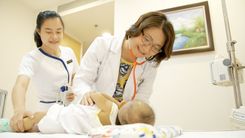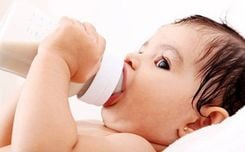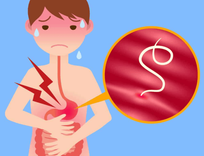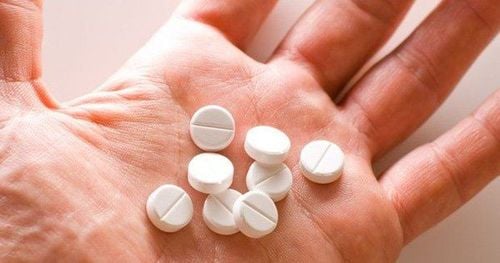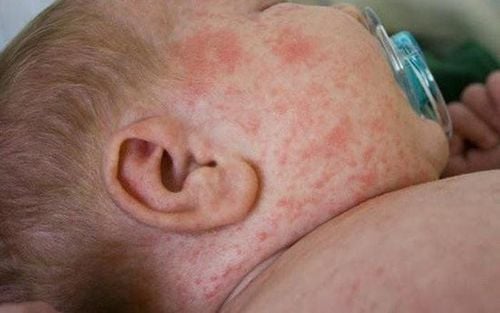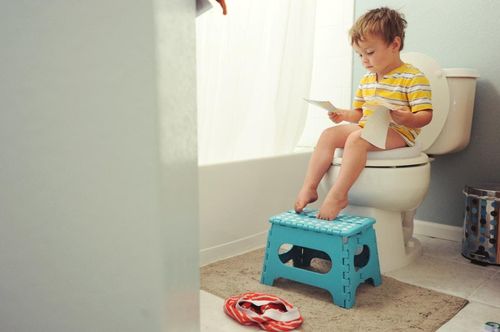One testicle is bigger than the other in newborns is a fairly common phenomenon recently, causing confusion and anxiety for parents. This may be a normal physiological phenomenon, but it can also be a dangerous disease. Parents need to pay attention to their child's development to detect it early and take them to the doctor in time.
1. What is the phenomenon of one testicle being bigger than the other in newborns?
One testicle is bigger than the other, or uneven testicles or testicle deviation is a phenomenon in which the two testicles are not the same size; one may be higher than the other, and in some cases, one testicle is less than half the size of the other.
If a newborn has one testicle bigger than the other without any abnormal symptoms such as swollen scrotum, redness or purple, fussiness, refusal to breastfeed, etc., this is a normal phenomenon. The cause is due to the uneven development of both testicles or while one testicle has descended into the scrotum, the other is still on the way from the abdomen. What needs to be done is to monitor the development of both testicles.
If one testicle is larger than the other due to a disease, the cause is usually the testicle developing outside the scrotum or misplaced testicles. This is a dangerous disease, easily leading to dangerous complications such as testicular cancer or male infertility.
2. Common diseases if a newborn has one testicle larger than the other
A newborn's testicles are larger than the others and may be related to the following diseases:
2.1. Undescended testicles
This is a common disease and is a top concern for newborns when one testicle is larger than the other. Undescended testicles are a phenomenon in which one or both testicles do not descend into the scrotum but remain in the abdomen. As is known, the body temperature is higher than needed for the development of the testicles; if the testicles are in the abdomen, it will damage the physiological and reproductive functions of this organ. For early detection, parents and caregivers need to check both testicles. If the testicles are not found on one or both sides, the child should be taken to the doctor immediately.
2.2. Inguinal hernia
Inguinal hernia often occurs immediately after birth in premature babies or can occur a few months or years after birth, especially after a period of coughing and straining. This is a phenomenon in which the organs or intestines in the abdomen descend to the child's groin through the inguinal canal because the inguinal canal has not closed. Parents may see a soft mass on the child's groin fold and change in size: small when the child lies down or larger when the child cries and strains. In this case, surgery is the most important treatment method. Surgery helps close the inguinal canal and return the child's organs to the correct anatomical position.
2.3. Hydrocele
This is a condition in which fluid in the abdomen gradually accumulates in the scrotal sac due to the inguinal canal not closing. Parents will notice that one testicle is larger but not painful. This condition may disappear naturally when the fluid is absorbed. However, if the hydrocele persists after 1 year of age, surgery is needed to drain the fluid for the child and then ligate the inguinal canal.
2.4. Spermatocele
Parents may notice a round or oval mass in the scrotum. This mass is usually smooth, painless, and located next to the testicle, so parents often think that one testicle is larger than the other. Treatment in this case is surgery to remove the spermatic cyst when the child is older.
3. Complications of one testicle being larger than the other if not treated
Newborns with one testicle larger than the other can experience acute and chronic complications if not treated promptly
3.1. Acute complications
Testicular torsion: This is a condition in which the spermatic cord is suddenly blocked due to the testicle rotating around its axis, thereby reducing or completely blocking blood flow to the testicle. The child will suddenly have severe pain in one testicle; the scrotum will swell red or purple. The pain may relieve itself if the child changes position and the testicle is untwisted. However, if the torsion lasts long, the testicle may be permanently damaged.
3.2. Strangulated inguinal hernia
The organs or intestines in the abdominal cavity are herniated into the inguinal canal and cannot be pushed out, leading to a lack of blood supply and damage. The child will be fussy and have severe pain, bloating, vomiting, and a painful, swollen mass in the scrotum. If left too late, it can lead to necrosis of the herniated organ, testicular damage, and peritonitis.
In addition to acute complications, the condition of one testicle being larger than the other due to pathological causes, if not treated, will leave several long-term complications for the child.
3.3. Damaged testicular membrane
The testicle of a newborn is larger than the other due to hydrocele, even damaging the testicle because then semen, blood, and substances in the abdominal cavity accumulate, making the testicles heavy and sagging. The testicles must stretch to contain the stagnant fluids.
3.4. Decreased sperm quality
If the testicles are not returned to the correct position, their quality will decrease, affecting the reproductive health of boys over time. Typically, this condition can lead to low sperm count and poor sperm quality.
3.5. Testicular cancer
Testicular cancer is rare in men. However, in the case of newborns with one testicle being larger than the other due to pathological causes, it can increase the risk of testicular cancer for the child. Because the testicles in the abdomen do not ensure the temperature for development, causing the testicles to gradually atrophy and possibly become malignant.
4. Diagnosis of large and small testicles in newborns
To diagnose and treat large and small testicles in newborns early, regular check-ups by parents are especially important. Accordingly, parents need to check right from birth and regularly check during the child's development. If parents discover that their child has one large and one small testicle, or only one side or no testicle in the scrotum, or in cases where the child's testicles are swollen, painful, or red, they need to take the child to the doctor immediately.
Some necessary tests will be conducted to help diagnose cases of newborns with large and small testicles.
Scrotal ultrasound: helps determine the case of undescended testicles
CT scan or laparoscopy helps diagnose in cases where the testicles in the scrotum cannot be felt or ultrasound does not show them.
Some other tests can also be performed to help diagnose, such as chromosome testing, endocrine testing, cancer markers, etc.
5. Ways to treat one testicle larger than the other in newborns
The most common and radical treatment method is surgery. This method helps to move the testicles to the correct position and fix them in the scrotum, helping the testicles to develop at the appropriate temperature.
The most appropriate time for surgery is when the child is 6–12 months old. This is the stage that best improves testicular function and reduces the risk of cancer.
In addition, there are some drug or hormone treatments. However, this is only a temporary solution while preparing the child to be eligible for surgery.
One testicle larger than the other in newborns is a genital abnormality that needs to be detected and treated early to ensure sexual function for boys and reduce the risk of cancer. Therefore, when seeing unusual signs in children, parents need to take them to hospitals for examination and treatment.
To arrange an appointment, please call HOTLINE or make your reservation directly HERE. You may also download the MyVinmec app to schedule appointments faster and manage your reservations more conveniently.
